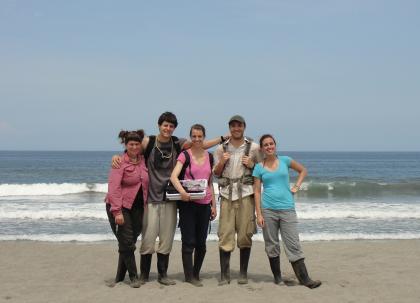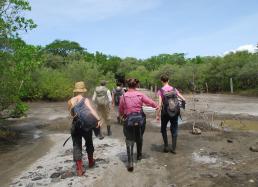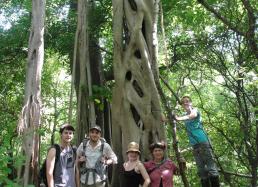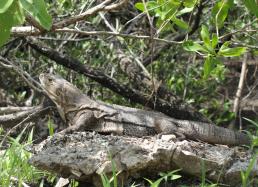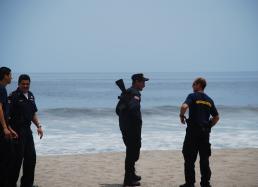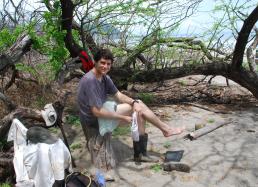Blog #14: A Day at the Beach
A day at beach was something that had been on everyone’s minds since we’d landed, especially with the Pacific coast being just an hour’s drive away from the field station. Ten days of consistently rainy weather spent largely under the forest canopy left many of us yearning for a bit of sun and surf, not to mention the promise of collecting more ants around the coastal dry forests and mangroves in this part of Santa Rosa National Park.
A brief dry spell and promising forecast on our last Saturday in Guanacaste finally gave us the conditions we needed to travel to nearby Playa Naranjo. After a bumpy commute to Rio Nisperal, whose normally shallow bed was too flooded to navigate by car, we parked our vehicles, packed up our gear, and set out on foot (see Photo #1 below.) With the wet season in full swing, the road from the river crossing to the beach was treacherously waterlogged, but it was an exciting hike nevertheless.
Among some of the unique marshland inhabitants we observed along the way were the visually striking purple-and-orange harlequin land crabs (Gecarcinus quadratus); several solitary caiman (Caiman crocodilus); a curious cat-eyed snake (Leptodeira rubricata); and a towering strangler fig (Ficus barbata) that had photo-op written all over it (see Photo #2 below.) Equally impressive were the ubiquitous black iguanas (Ctenosaura similis), giant 4-foot-long creatures that had taken over the Playa Naranjo campsite in quite astonishing numbers (see Photo #3 below.)
The beach was every bit as breathtaking as we’d all imagined, with the legendary Peña Bruja (or Witch’s Rock) to the north and a sprawling coastal lagoon to the south. Playa Naranjo happened to be an extremely popular destination for surfers, as we’d later learn, but thanks again to the rainy season, we had the place almost entirely to ourselves. A group of four coast guards (two of them armed) appeared at one point, arousing concern that we might be reprimanded for disregarding the beach trail’s seasonal closure, but they ignored us and left to investigate some unseen activity at the border (see Photo #4 below.)
After a few fleeting hours of swimming and sunbathing (see Photo #5 below), we got to work hunting down ants in the dry forest immediately abutting the coast, and later migrated to the mangrove forest further inland where the tireless bait-trapping, aspirating, sifting, and hand-collecting continued. (To learn more about this process, check out our “How to Collect Ants” Video and our "Tools and Techniques" Photo Gallery.) It was a productive excursion for the whole team, and it was immensely rewarding to finally get to see the pristine Costa Rican coast firsthand. Definitely an experience to remember.
Best,
Alex

